170905-MyBatis中的关系映射
===关系映射===
参考文档复习:1对1,1对多,多对多
1.映射(多)对一、(一)对一的关联关系
1).使用列的别名
①.若不关联数据表,则可以得到关联对象的id属性
②.若还希望得到关联对象的其它属性。则必须关联其它的数据表
1.创建表:
员工表:
DROP TABLE IF EXISTS `tbl_employee`;
CREATE TABLE `tbl_employee` (
`id` int(11) NOT NULL AUTO_INCREMENT,
`user_name` varchar(255) DEFAULT NULL,
`gender` char(1) DEFAULT NULL,
`email` varchar(255) DEFAULT NULL,
`d_id` int(11) DEFAULT NULL,
PRIMARY KEY (`id`),
KEY `fk_emp_dept` (`d_id`),
CONSTRAINT `fk_emp_dept` FOREIGN KEY (`d_id`) REFERENCES `tbl_dept` (`id`))
ENGINE=InnoDB AUTO_INCREMENT=5 DEFAULT CHARSET=utf8;
部门表:
CREATE TABLE tbl_dept(
id INT(11) PRIMARY KEY AUTO_INCREMENT,
dept_name VARCHAR(255) )
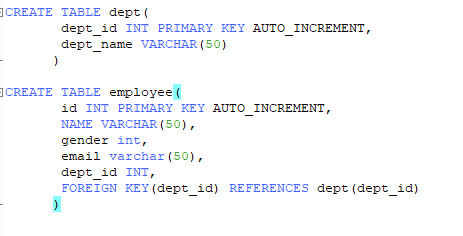
2.创建相应的实体类和Mapper接口!


3.写关联的SQL语句
SELECT e.`id` id , e.`user_name` user_name, e.`gender` gender,e.`d_id` d_id,d.`id` did,d.`dept_name` dept_name
FROM `tbl_employee` e, tbl_dept d
WHERE e.`d_id` = d.`id` AND e.id = 1

4.在sql映射文件中写映射sql语句【联合查询:级联属性封装结果集】
<!-- 联合查询:级联属性封装结果集 -->
<resultMap type="com.neuedu.entity.Employee" id="getEmployeeAndDeptMap">
<id column="id" property="id"/>
<result column="user_name" property="userName"/>
<result column="gender" property="gender"/>
<result column="email" property="email"/>
<result column="did" property="depart.id"/>
<result column="dept_name" property="depart.deptName"/>
</resultMap>
<!-- public Employee getEmployeeAndDept(Integer id); -->
<select id="getEmployeeAndDept" resultMap="getEmployeeAndDeptMap">
SELECT e.`id` id , e.`user_name` user_name, e.`gender` gender,e.`email` email,e.`d_id` d_id,d.`id` did,d.`dept_name` dept_name
FROM `tbl_employee` e, tbl_dept d
WHERE e.`d_id` = d.`id` AND e.id = #{id}
</select>
注意:即使使用resultMap来映射,对于“对一”关联关系可以不使用association
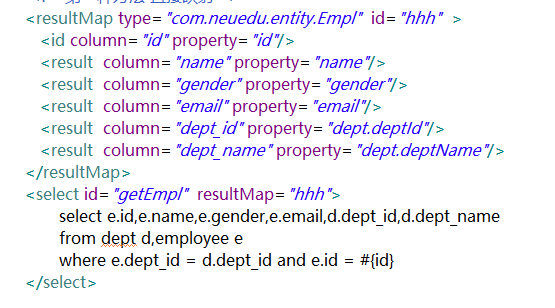
5.编写测试用例
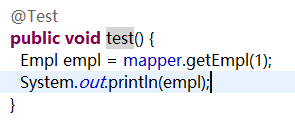
方法二:【使用association来定义关联对象的规则,[比较正规的,推荐的方式]】
<!-- 联合查询:使用association封装结果集 -->
<resultMap type="com.neuedu.entity.Employee" id="getEmployeeAndDeptMap">
<id column="id" property="id"/>
<result column="user_name" property="userName"/>
<result column="gender" property="gender"/>
<result column="email" property="email"/>
<!-- association可以指定联合的javaBean对象 property="depart":指定哪个属性是联合的对象 javaType:指定这个属性对象的类型【不能省略】 -->
<association property="depart" javaType="com.neuedu.entity.Department">
<id column="did" property="id"/>
<result column="dept_name" property="deptName"/>
</association>
</resultMap>
<!-- public Employee getEmployeeAndDept(Integer id); -->
<select id="getEmployeeAndDept" resultMap="getEmployeeAndDeptMap">
SELECT e.`id` id , e.`user_name` user_name, e.`gender` gender,e.`email` email,e.`d_id` d_id,d.`id` did,d.`dept_name` dept_name
FROM `tbl_employee` e, tbl_dept d
WHERE e.`d_id` = d.`id` AND e.id = #{id}
</select>
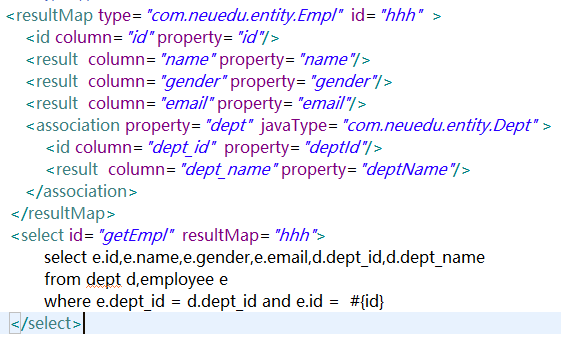
方法三[上述结果相当于使用嵌套结果集的形式]【我们这里还可以使用Association进行分步查询】:
<!-- 使用association进行分步查询 1.先按照员工id查询员工信息 2.根据查询员工信息中d_id值取部门表查出部门信息 3.部门设置到员工中: -->
<select id="getDepartById" resultType="com.neuedu.entity.Department">
SELECT id ,dept_name deptName FROM tbl_dept WHERE id = #{id}
</select>
<resultMap type="com.neuedu.entity.Employee" id="myEmpByStep">
<id column="id" property="id"/>
<result column="user_name" property="userName"/>
<result column="gender" property="gender"/>
<result column="email" property="email"/>
<!-- association定义关联对象的封装规则 select:表明当前属性是调用指定的方法查出的结果 column:指定将哪一列的值传给这个方法 流程:使用select指定的方法(传入column指定的这列参数的值)查出对象,并封装给property指定的属性。 -->
<association property="depart" select="getDepartById" column="d_id"></association>
</resultMap>
<!-- public Employee getEmpAndDept(Integer id); -->
<select id="getEmpAndDept" resultMap="myEmpByStep">
select * from tbl_employee where id =#{id}
</select>
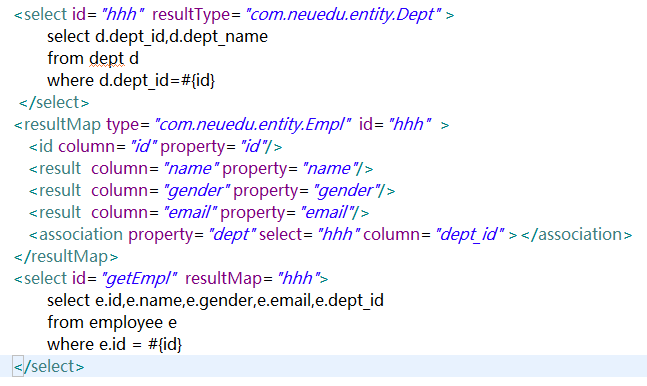
补充:懒加载机制【按需加载,也叫懒加载】:
<!-- 在分步查询这里,我们还要讲到延迟加载: Employee === > Dept: 我们每次查询Employee对象的时候,都将关联的对象查询出来了。
而我们想能不能我在需要部门信息的时候,再去查询,不需要的时候就不用查询了。
答案:可以的 我们只需要在分步查询的基础之上加上两个配置:
1.在mybatis的全局配置文件中加入两个属性:
<settings>
<setting name="mapUnderscoreToCamelCase" value="true"/>
<!-- 开启懒加载机制 ,默认值为true-->
<setting name="lazyLoadingEnabled" value="true"/>
<!-- 开启的话,每个属性都会直接全部加载出来;禁用的话,只会按需加载出来 -->
<setting name="aggressiveLazyLoading" value="false"/>
</settings>
测试:
@Test
public void testGetEmployee(){
EmployeeMapperPlus mapper = openSession.getMapper(EmployeeMapperPlus.class);
Employee employee = mapper.getEmpAndDept(1);
System.out.println(employee.getUserName());
}
此时:可以看到这里只发送了一条SQL语句。
注意:上面我们上面如果关联的是一个对象,我们还可以使用association标签,如果我们关联的是一个集合, 那么该使用谁呢?
===映射对多的关联关系===
场景二:查询部门的时候,将部门对应的所有员工信息也查询出来,注释在DepartmentMapper.xml中
第一种:
1.修改Department实体类【添加Employee集合,并为该集合提供getter/setter方法】
public class Department {
private Integer id;
private String deptName;
private List<Employee> list;
public List<Employee> getList() {
return list;
}
public void setList(List<Employee> list) {
this.list = list;
} ......
}
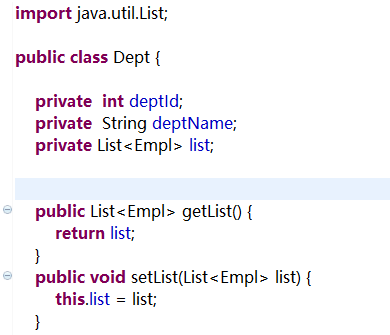
建立DepartmentMapper接口文件,并添加如下方法:
public Department getDeptByIdPlus(Integer id);

2.sql映射文件中的内容为:【collection:嵌套结果集的方式:使用collection标签定义关联的集合类型元素的封装规则】
<!-- public Department getDeptByIdPlus(Integer id); -->
<resultMap type="com.neuedu.entity.Department" id="getDeptByIdPlusMap">
<id column="did" property="id"/>
<result column="dept_name" property="deptName"/>
<!-- collection:定义关联集合类型的属性的封装规则 ofType:指定集合里面元素的类型 -->
<collection property="list" ofType="com.neuedu.entity.Employee">
<!-- 定义这个集合中元素的封装规则 -->
<id column="eid" property="id"/>
<result column="user_name" property="userName"/>
<result column="email" property="email"/>
<result column="gender" property="gender"/>
</collection>
</resultMap>
<select id="getDeptByIdPlus" resultMap="getDeptByIdPlusMap">
SELECT d.`id` did, d.`dept_name` dept_name,e.`id` eid,e.`user_name` user_name,e.`email` email,e.`gender` gender
FROM `tbl_dept` d
LEFT JOIN tbl_employee e
ON e.`d_id` = d.`id`
WHERE d.`id` = #{id}
</select>
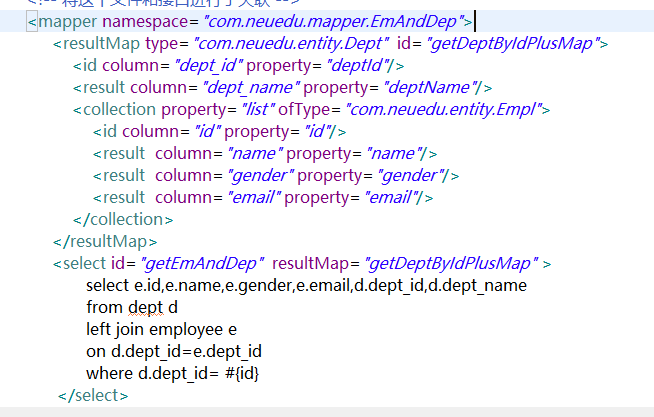
3.测试方法为:
@Test
public void testGetEmployee(){
DepartmentMapper mapper = openSession.getMapper(DepartmentMapper.class);
Department department = mapper.getDeptByIdPlus(2);
System.out.println(department);
}
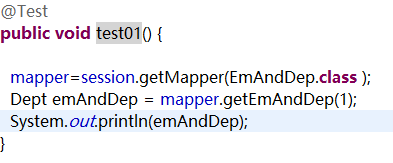
第二种:使用分步查询结果集的方式:
1.如果使用分步查询的话,我们的sql语句就应该为:
SELECT * FROM `tbl_dept` WHERE id = 2;
SELECT * FROM `tbl_employee` WHERE d_id = 2;
2.在DepartmentMapper接口文件中添加方法,如下所示:
public Department getDeptWithStep(Integer id);
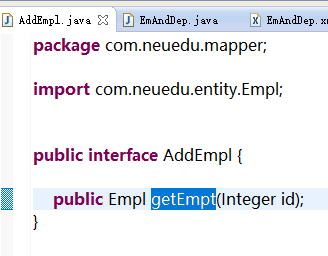
3.再从EmployeeMapper接口中添加一个方法,如下所示:
public List<Employee> getEmployeeByDeptId(Integer deptId);
并在响应的sql映射文件中添加相应的sql语句
<select id="getEmployeeByDeptId" resultType="com.neuedu.entity.Employee">
select * from tbl_employee where d_id = #{departId}
</select>
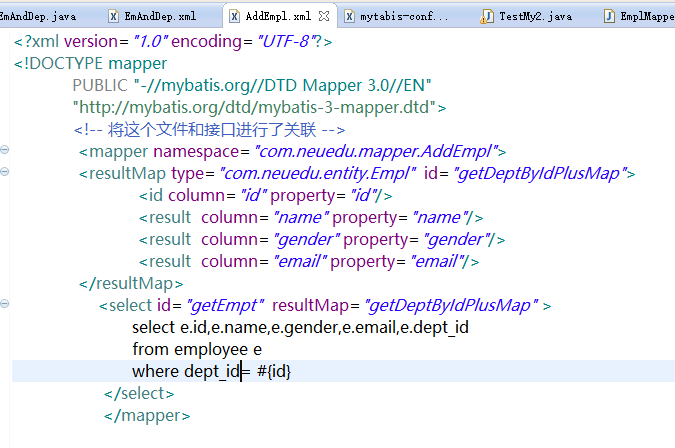
4.在DepartmentMapper映射文件中:
<resultMap type="com.neuedu.entity.Department" id="getDeptWithStepMap">
<id column="id" property="id"/>
<result column="dept_name" property="deptName"/>
<collection property="list" select="com.neuedu.mapper.EmployeeMapper.getEmployeeByDeptId" column="id">
</collection>
</resultMap>
<select id="getDeptWithStep" resultMap="getDeptWithStepMap">
SELECT id ,dept_name FROM tbl_dept WHERE id = #{id}
</select>

5.测试类:
@Test
public void testGetEmployee(){
DepartmentMapper mapper = openSession.getMapper(DepartmentMapper.class);
Department department = mapper.getDeptWithStep(2);
System.out.println(department);
}
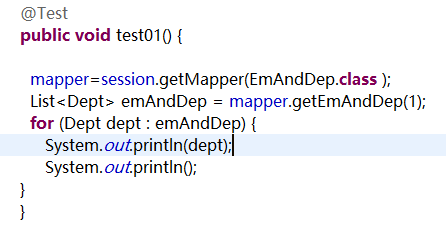
总结:
1.映射(一)对多、(多)对多的关联关系=======》【映射"对多"的关联关系】
2.必须使用collection节点进行映射
3.注意ofType指定集合中的元素类型
4.<!-- collection标签 映射多的一端的关联关系,使用ofType指定集合中的元素类型 columnprefix:指定列的前缀 使用情境:若关联的数据表和之前的数据表有相同的列名,此时就需要给关联的列其"别名". 若有多个列需要起别名,可以为所有关联的数据表的列都加上相同的前缀,然后再映射时指定前缀。 -->
170905-MyBatis中的关系映射的更多相关文章
- Mybatis中对象关系映射
在实际开发中,实体类之间有一对一.一对多.多对多的关系,所以需要正确配置它们对应关系,Mybatis通过配置文件能够从数据库中获取列数据后自动封装成对象. 如:一个订单Orders类对应一个用户Use ...
- mybatis中一对一关系映射
一对一关系中普通的配置方式 一.多表连接查询语句: <select id="selectStudentWithAddress" parameterType="int ...
- 【mybatis深度历险系列】mybatis中的高级映射一对一、一对多、多对多
学习hibernate的时候,小编已经接触多各种映射,mybatis中映射有到底是如何运转的,今天这篇博文,小编主要来简单的介绍一下mybatis中的高级映射,包括一对一.一对多.多对多,希望多有需要 ...
- 【mybatis深度历险系列】mybatis中的输入映射和输出映射
在前面的博文中,小编介绍了mybatis的框架原理以及入门程序,还有mybatis中开发到的两种方法,原始开发dao的方法和mapper代理方法,今天博文,我们来继续学习mybatis中的相关知识,随 ...
- Hibernate(三)——框架中的关系映射
在设计数据库时我们会考虑,表与表之间的关系,例如我们前边经常提到的一对一,一对多,多对多关系,在数据库中我们通过外键,第三张表等来实现这些关系.而Hibernate时间实体类和数据库中的表进行的映射, ...
- Hibernate 中对象关系映射(ObjectRelationMapping)
1.什么是对象关系映射? 解析:对象-关系映射(Object Relational Mapping,简称ORM,对象关系映射)是一种为了解决面向对象与关系数据库存在的互不匹配的现象的技术. 简单的说, ...
- Hibernate框架(三)框架中的关系映射
在设计数据库时我们会考虑,表与表之间的关系,例如我们前边经常提到的一对一,一对多,多对多关系,在数据库中我们通过外键,第三张表等来实现这些关系.而Hibernate时间实体类和数据库中的表进行的映射, ...
- Mybatis中的关联映射和查询
一.商品订单数据模型 1.数据表 这里定义了四个表,分别表示用户,商品,订单,和订单详情. 用户表user CREATE TABLE `user` ( `id` int(11) NOT NULL AU ...
- 【spring实战第五版遇到的坑】3.2中配置关系映射时,表名和3.1中不一样
3.2章中按照书中的步骤写好相应类的映射关系,发现启动时,之前在3.1章中建的表全部被删重新建立了,并且Ingredient表的数据没了,由于使用了JPA,默认使用的是hibernate,在启动时会删 ...
随机推荐
- 前端 CSS 盒子模型 边框 border属性
边框 border:边框的意思,描述盒子的边框 边框有三个要素: 粗细 线性样式 颜色 border: solid border特性 如果颜色不写,默认是黑色.如果粗细不写,不显示边框.如果只写线性样 ...
- [转帖]K8s集群安装--最新版 Kubernetes 1.14.1
K8s集群安装--最新版 Kubernetes 1.14.1 http://www.cnblogs.com/jieky/p/10679998.html 原作者写的比较简单 大略流程和跳转的多一些 改天 ...
- 解决org.apache.subversion.javahl.ClientException的方法【】
重新刷新项目,配置项目,总是报“The project was not built due to "org.apache.subversion.javahl.ClientException” ...
- UUID工具类及使用
1.工具类: package UUIdtest; import java.util.UUID; public class UUIDUtil { public static String getUUID ...
- 使用Postwoman
postman的脱单产品postwoman 一.安装 1.使用git进行安装: git clone https://github.com/liyasthomas/postwoman cd postwo ...
- viewset的使用的方法
viewset的使用方法中是怎么区分的update和crate modelViewSet中设置了这个类之后,设置了类成员变量:queryset 和 seriazlier class,所以POST操作直 ...
- vue项目如何监听窗口变化,达到页面自适应?
[自适应]向来是前端工程师需要解决的一大问题--即便作为当今非常火热的vue框架,也无法摆脱--虽然elementui.iview等开源UI组件库层出不穷,但官方库毕竟不可能满足全部需求,因此我们可以 ...
- 计算机系统结构总结_Cache Optimization
Textbook: <计算机组成与设计——硬件/软件接口> HI <计算机体系结构——量化研究方法> QR Ch4. Cache Optimization 本章要 ...
- 自我笔记,Rides介绍
Redis是一个key-value存储系统,和Memccached类似,支持存储的value类型相对更多,很大程度上补偿memcached这类key-value存储的不足 他提供了Java,c/c++ ...
- 使用SQL语法来查询Elasticsearch:Elasticsearch-SQL插件
简介 Elasticsearch-SQL是Elasticsearch的一个插件,它可以让我们通过类似SQL的方式对Elasticsearch中的数据进行查询.项目地址是:https://github. ...
